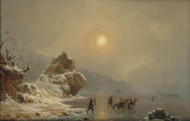Andreas Achenbach
Published by Therese Myles on 17th Mar 2020
Andreas Achenbach lived a very long and distinguished life as an artist. He was born in 1815 and died in 1910, which was a particularly impressive lifespan for someone born in the nineteenth century. Impressively enough, Andreas Achenbach was something of a child prodigy with regards to his artistic talent as well. He was only fourteen when he managed to sell art for the first time, thus officially becoming a professional artist. He was only twelve when he started studying at the Dusseldorf Academy, working with very talented instructors all the while. Andreas Achenbach was able to enjoy a fairly lengthy period of artistic success.
The Romantic style of art was very much the dominant style in the art world of the day. The Romantics celebrated artists and their unique visions. However, ironically enough, the Romantic style itself quickly became just another standard. Artists that wanted to be truly unique, such as Andreas Achenbach, had to actually deviate from the Romantic tradition in order to do so.
Romanticism rejected realism in many ways. This rejection is evident throughout the writings of nineteenth century Romantics, and it is subtly reflected in their art. Embracing realism was a way to react against the Romantics, and that's more or less what Andreas Achenbach tried to accomplish within his own landscape paintings.
Indeed, what's immediately noticeable about the paintings of Andreas Achenbach is their exquisite detail. He was clearly an artist that was interested in trying to capture landscapes they way they were, as opposed to the way he imagined them to be in his own mind. Many of his paintings depict the ocean, capturing the experience of sailors. While the focus is always on the landscapes, viewers can still get a sense of what these places may have really looked like when he first painted them.
The Romantics had a fixation on medieval times, given their very strong sense of nostalgia and anxiety about the changing social and technological standards of their time. Many of Andreas Achenbach's paintings are clearly set in what would have been considered modern times. He was interested in depicting the natural world of the nineteenth century with accuracy as opposed to embellishment. Some of his paintings almost look and feel like lovingly constructed photographs.
In 1832, Andreas Achenbach visited the North Sea with his father in order to create art. He got to experience a lot of the natural world in Holland, which more or less set the stage for how Andreas Achenbach would create art in the future.
While Andreas Achenbach had excellent instructors at the Dusseldorf Academy, he found himself experiencing a dilemma that is very common among art students. On the one hand, art students need to see what other artists have done in order to avoid creating something that is too close to the work of others. On the other hand, if young artists study the work of other artists too much, they risk ending up losing their own unique touch. As such, Andreas Achenbach ended up moving on from Dusseldorf in 1835. This decision would prove to be instrumental in the development of Andreas Achenbach's artistic oeuvre.
He traveled all throughout Europe, visiting Sweden, Norway, southern Germany, and Denmark between 1835 and and 1839. Many people associate these areas with seafaring and seascapes, and that's the element that Andreas Achenbach managed to capture with each one of his paintings. Many seascapes portray the ocean as a tranquil place for relaxation, approaching it from the perspective of a tourist. Some of Andreas Achenbach's paintings were like that, but many of them portrayed the ocean in all of its chaotic majesty. German landscape painting was changed forever, thanks to the life and times of Andreas Achenbach.

